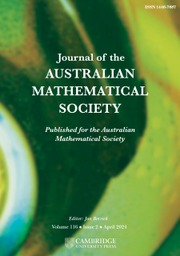Article contents
COEFFICIENT INEQUALITIES AND YAMASHITA’S CONJECTURE FOR SOME CLASSES OF ANALYTIC FUNCTIONS
Published online by Cambridge University Press: 29 September 2015
Abstract
For any real number  ${\it\beta}$ with
${\it\beta}$ with  ${\it\beta}>1$, let
${\it\beta}>1$, let  ${\mathcal{M}}(\,{\it\beta})$ (
${\mathcal{M}}(\,{\it\beta})$ ( ${\mathcal{N}}(\,{\it\beta})$ respectively) denote the class of analytic functions
${\mathcal{N}}(\,{\it\beta})$ respectively) denote the class of analytic functions  $f$ in the unit disk
$f$ in the unit disk  $\mathbb{D}:=\{z\in \mathbb{C}:|z|<1\}$ of the form
$\mathbb{D}:=\{z\in \mathbb{C}:|z|<1\}$ of the form  $f(z)=z+\sum _{n=2}^{\infty }a_{n}z^{n}$ and satisfying
$f(z)=z+\sum _{n=2}^{\infty }a_{n}z^{n}$ and satisfying  $\text{Re}\,P_{f}<{\it\beta}$ (
$\text{Re}\,P_{f}<{\it\beta}$ ( $\text{Re}\,Q_{f}<{\it\beta}$ respectively) in
$\text{Re}\,Q_{f}<{\it\beta}$ respectively) in  $\mathbb{D}$, where
$\mathbb{D}$, where  $P_{f}=zf^{\prime }(z)/f(z)$ and
$P_{f}=zf^{\prime }(z)/f(z)$ and  $Q_{f}=1+zf^{\prime \prime }(z)/f^{\prime }(z)$. Also, for
$Q_{f}=1+zf^{\prime \prime }(z)/f^{\prime }(z)$. Also, for  ${\it\beta}>1$, let
${\it\beta}>1$, let  ${\mathcal{M}}{\rm\Sigma}(\,{\it\beta})$ (
${\mathcal{M}}{\rm\Sigma}(\,{\it\beta})$ ( ${\mathcal{N}}{\rm\Sigma}(\,{\it\beta})$ respectively) denote the class of analytic functions
${\mathcal{N}}{\rm\Sigma}(\,{\it\beta})$ respectively) denote the class of analytic functions  $g$ of the form
$g$ of the form  $g(z)=z(1+\sum _{n=1}^{\infty }b_{n}z^{-n})$ and satisfying
$g(z)=z(1+\sum _{n=1}^{\infty }b_{n}z^{-n})$ and satisfying  $\text{Re}\,P_{g}<{\it\beta}$ (
$\text{Re}\,P_{g}<{\it\beta}$ ( $\text{Re}\,Q_{g}<{\it\beta}$ respectively) for
$\text{Re}\,Q_{g}<{\it\beta}$ respectively) for  $z\in {\rm\Delta}=\{z\in \mathbb{C}:1<|z|<\infty \}$. In this paper, we shall determine the coefficient bounds, inverse coefficient bounds, the growth and distortion theorem and the upper bounds for the Fekete–Szegő functional
$z\in {\rm\Delta}=\{z\in \mathbb{C}:1<|z|<\infty \}$. In this paper, we shall determine the coefficient bounds, inverse coefficient bounds, the growth and distortion theorem and the upper bounds for the Fekete–Szegő functional  ${\rm\Lambda}_{{\it\lambda}}(f)=a_{3}-{\it\lambda}a_{2}^{2}$ for functions
${\rm\Lambda}_{{\it\lambda}}(f)=a_{3}-{\it\lambda}a_{2}^{2}$ for functions  $f$ in the classes
$f$ in the classes  ${\mathcal{M}}(\,{\it\beta})$ and
${\mathcal{M}}(\,{\it\beta})$ and  ${\mathcal{N}}(\,{\it\beta})$. Further, we shall solve the maximal area problem for functions of the type
${\mathcal{N}}(\,{\it\beta})$. Further, we shall solve the maximal area problem for functions of the type  $z/f(z)$ when
$z/f(z)$ when  $f\in {\mathcal{M}}(\,{\it\beta})$, which is Yamashita’s conjecture for the class
$f\in {\mathcal{M}}(\,{\it\beta})$, which is Yamashita’s conjecture for the class  ${\mathcal{M}}(\,{\it\beta})$. We shall obtain the radius of convexity for the class
${\mathcal{M}}(\,{\it\beta})$. We shall obtain the radius of convexity for the class  ${\mathcal{N}}(\,{\it\beta})$. We shall also determine the coefficient bounds for functions
${\mathcal{N}}(\,{\it\beta})$. We shall also determine the coefficient bounds for functions  $g$ in the classes
$g$ in the classes  ${\mathcal{M}}{\rm\Sigma}(\,{\it\beta})$ and
${\mathcal{M}}{\rm\Sigma}(\,{\it\beta})$ and  ${\mathcal{N}}{\rm\Sigma}(\,{\it\beta})$ and the inverse coefficient bounds for functions
${\mathcal{N}}{\rm\Sigma}(\,{\it\beta})$ and the inverse coefficient bounds for functions  $g$ in the class
$g$ in the class  ${\mathcal{M}}{\rm\Sigma}(\,{\it\beta})$. All the results are sharp.
${\mathcal{M}}{\rm\Sigma}(\,{\it\beta})$. All the results are sharp.
Keywords
MSC classification
Information
- Type
- Research Article
- Information
- Copyright
- © 2015 Australian Mathematical Publishing Association Inc.
References
- 5
- Cited by

